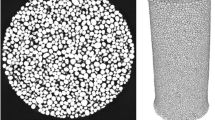Abstract
This paper details the ‘level set bridge’: a single platform for the characterization of various aspects of granular micro-mechanics, including grain morphology, grain kinematics, and inter-granular contact. This platform is studied and verified for accuracy using synthetic examples, in particular, its robustness with respect to the variables of image resolution and noise. The level set bridge is then applied to analysis of XRCT images of real 3D triaxial experiments of two types of granular materials. Contact statistics and kinematics are reported inside and outside of the failure band of one, and kinematics inside a failure band are reported in the other, from preload to critical state.







Similar content being viewed by others
Notes
... and also capillary effects though in our case, the specimen were tested dry and not affected by capillary effects
References
Andò E, Hall S, Viggiani G, Desrues J, Bésuelle P (2012) Grain-scale experimental investigation of localised deformation in sand: a discrete particle tracking approach. Acta Geotech 7:1–13. doi:10.1007/s11440-011-0151-6
Andò E, Hall S, Viggiani G, Desrues J, Bésuelle P (2012) Experimental micromechanics: grain-scale observation of sand deformation. Géotech Lett 2(3):107–112
Andrade J, Tu X (2009) Multiscale framework for behavior prediction in granular media. Mech Mater 41(6):652–669
Andrade J, Avila C, Hall S, Lenoir N, Viggiani G (2010) Multiscale modeling and characterization of granular matter: from grain kinematics to continuum mechanics. J Mech Phys Solids 59:237–250
Andrade JE, Vlahinić I, Lim K-W, Jerves A (2012) Multiscale tomography-to-simulation framework for granular matter: the road ahead. Géotech Lett 2:135–139. doi:10.1680/geolett.12.00023
Bagi K (1996) Stress and strain in granular assemblies. Mech Mater 22:165–177
Behringer R, Bi D, Chakraborty B, Clark A, Dijksman J, Ren J, Zhang J (2014) Statistical properties of granular materials near jamming. J Stat Mech Theory Exp 2014(6):P06004
Calvetti F, Combe G, Lanier J (1997) Experimental micromechanical analysis of 2d granular material: relation between structure evolution and loading path. Mech Cohes Frict Mater 2:121–163
Caselles V, Catté F, Coll T, Dibos F (1993) A geometric model for active contours in image processing. Numer Math 66:1–31. doi:10.1007/bf01385685
Jenkinson M, Bannister P, Brady M, Smith S (2002) Improved optimization for the robust and accurate linear registration and motion correction of brain images. Neuroimage 17:825–841
Kichenassamy S, Kumar A, Olver P, Tannenbaum A, Yezzi A (1996) Conformal curvature flows: from phase transitions to active vision. Arch Ration Mech Anal 134:275–301
Li X, Dafalias Y (2012) Anisotropic critical state theory: role of fabric. J Eng Mech 138:263–275. doi:10.1061/(ASCE)EM.1943-7889.0000324
Li C, Xu C, Gui C, Fox MD (2005) Level set evolution without re-initialization: a new variational formulation. In: Proceedings of the IEEE, computer vision and pattern recognition, pp 430–436
Li C, Xu C, Gui C, Fox MD (2010) Distance regularized level set evolution and its application to image segmentation. In: Proceedings of the IEEE, image processing, pp 3243–3254
Oda M (1972) Initial fabrics and their relations to mechanical properties of granular material. Soils Found 12:17–36
Oda M, Iwashita K (1999) Mechanics granular materials, an introduction, 1st edn. Balkema, Rotterdam
Osher S, Sethian JA (1988) Fronts propagating with curvature-dependent speed: algorithms based on Hamilton-Jacobi formulations. J Comput Phys 79:12–49
Rechemacher A, Finno R (2004) Digital image correlation to evaluate shear banding in dilative sands. Geotech Test J 27:13–22
Santamarina JC (2003) Soil behavior at the microscale: particle forces. In: Proceedings of a ASCE, soil behavior and soft ground construction, pp 25–56. doi:10.1061/40659(2003)2
Schofield A, Wroth P (1968) Critical state soil mechanics. McGraw-Hill, New York
Vlahinić I, Andò E, Viggiani G, Andrade JE (2013) Towards a more accurate characterization of granular media: extracting quantitative descriptors from tomographic images. Granul Matter 16:9–21
Author information
Authors and Affiliations
Corresponding author
Rights and permissions
About this article
Cite this article
Vlahinić, I., Kawamoto, R., Andò, E. et al. From computed tomography to mechanics of granular materials via level set bridge. Acta Geotech. 12, 85–95 (2017). https://doi.org/10.1007/s11440-016-0491-3
Received:
Accepted:
Published:
Issue Date:
DOI: https://doi.org/10.1007/s11440-016-0491-3




